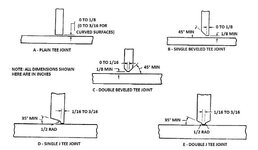Depending on the strength needed, there are different types of tee joint welds that can be used. The main types of Tee-Joints are:
a)Plain Tee-Joint,
b)Single Beveled Tee-Joint,
c)Double Beveled Tee-Joint,
d)Single-J Tee Joint,
e)Double-J Tee Joint.
For Welding Procedures Specifications(WPS) of plain Tee-Joint, A qualified WPS based on test piece with fillet welds could be used to welding of plain Tee-Joint.
So, if I want to weld beveled Tee-Joint(Single Beveled Tee-Joint, Double Beveled Tee-Joint, Single-J Tee Joint, Double-J Tee Joint), what type of test piece should be prepared and what tests should be conducted?
Thank you.
a)Plain Tee-Joint,
b)Single Beveled Tee-Joint,
c)Double Beveled Tee-Joint,
d)Single-J Tee Joint,
e)Double-J Tee Joint.
For Welding Procedures Specifications(WPS) of plain Tee-Joint, A qualified WPS based on test piece with fillet welds could be used to welding of plain Tee-Joint.
So, if I want to weld beveled Tee-Joint(Single Beveled Tee-Joint, Double Beveled Tee-Joint, Single-J Tee Joint, Double-J Tee Joint), what type of test piece should be prepared and what tests should be conducted?
Thank you.


